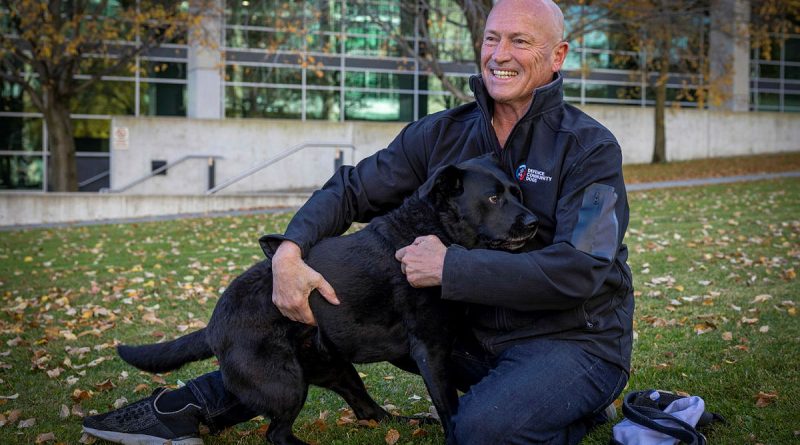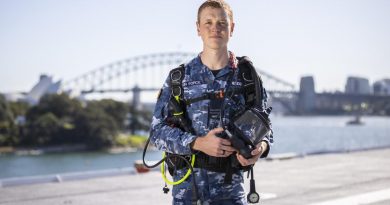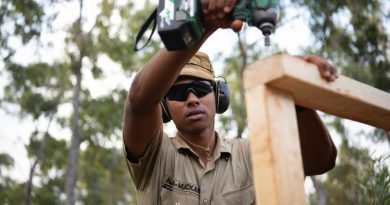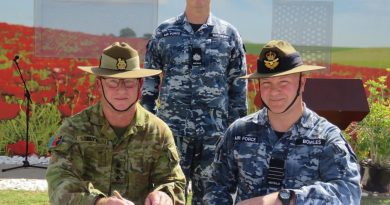Veteran owes it all to man’s best friend

PTSD almost destroyed Mick Nobes’ life, but a helping paw helped him turn things around.
CAPTION: Michael Nobes, a former Navy clearance diver, and his assistance dog Lola outside Russell Offices, Canberra, for a fundraising and awareness barbeque to support Defence Community Dogs. Story and photo by Corporal Jacob Joseph.
The former clearance diver had “rubbish” in his head after 24 years in Navy and time spent removing unexploded bombs from Laos and Cambodia.
“I wouldn’t leave the house or get out of bed until two in the afternoon,” Mr Nobes said.
“I didn’t deal with people well.”
It wasn’t until he met a black labrador named Lola that things started to turn around.
They were connected through Defence Community Dogs (DCD), an independent program that provides assistance dogs to current and ex-serving personnel at no cost.
Established in 2014, DCD has paired 84 assistance dogs with dozens more in training.
Each dog has more than 10 months or 250 hours around-the-clock training from inmates at Bathurst correctional centre, operating under instruction from dog trainers.
It’s a “win, win, win”, according to managing director Leanne Kyle.
She said the dogs are rescued from shelters and trained by inmates, which assists with their rehabilitation, and then matched with personnel according to their physical and emotional needs.
“We want to help veterans get out as much as they can, like going to the footy, catching up with friends and family,” Mrs Kyle said.
“It all sounds simple, but once they get to the stage of PTSD, where they’re withdrawn, they just stop.”
As well as helping veterans get back into the community, the dogs get bespoke training too.
Lola is trained to activate a light and lick Mr Nobes’ face at early signs of nightmares.
“I’ll wake up, do my breathing exercises and get my heart rate down,” Mr Nobes said.
“She’ll feel that, and as soon as I hit 60bpm she’ll slip off the bed, turn the light off and go back to her crate.”
Mr Nobes’ physical and mental wellbeing have improved since he got Lola, and he’s now back to the person he was before. But conquering PTSD wasn’t as easy as switching off a light.
“I sat on the Lachlan River in NSW about three or four months after I had Lola and was going to do something bad,” he said.
“But verbalising it to her on the banks of the river kept me here.”
Mr Nobes said Lola was 24 hours from getting euthanised when she was selected for training as an assistance dog – rescued from the pound so she could rescue him that day on the river.
And now he is the program’s greatest advocate.
“I wouldn’t be here without her, I owe this program my life,” he said.
.
.

.
.






PTSD is the great destroyer. Without help, it inevitably takes a negative turn. Without help, suicide is a viable option. The results of which have taken more than 16 veterans a day. In the USA This rate has been relatively steady over the past twenty years. I don’t know what Australia’s rate is, I hope it’s much lower. Doing the math: 16x365x20=116,800 veterans have died from suicide in the past twenty years. I cannot grasp this number, I just can’t wrap my mind around this large of a number. Every victory is priceless. Every loss drives more to consider suicide as an option to end the pain. I’m winning my battles by staying busy. Busy to exhaustion every day. The VA provides counseling and support to help my fight. The nightmares visit me every night. The dead haunt my dreams. The destruction I’ve seen can become overwhelming. Memories are not my friends. There are good memories and I hang on to them. They are a shield. My dog isn’t trained as a support dog but she knows when a nightmare has kicked off and she licks my hands and face till I wake up.
Mr Nobes has found his victory. I pray more Vets find there’s as well.
Semper Fi.
Son #2 has related issues but has grown through support to the point where life is good and the dreams – nightmares – are fewer. There’s no healing, just coping, with the right people around you.